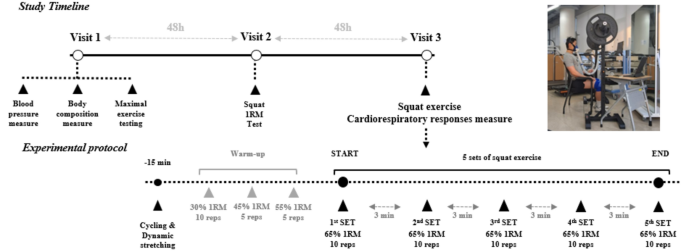Fitness
Cardiorespiratory and aerobic demands of squat exercise – Scientific Reports

The main questions of our study are to examine the maximal V̇O2 achieved during five sets of squat exercises (10 reps per set, 5 sets, 3 min rest interval, 65% of 1RM) in relation to predetermined V̇O2max and how these values differ according to participants’ training status. Our study showed that the highest V̇O2 was observed during the 5th set of squat exercises, almost reaching 100% of the participants’ predetermined V̇O2max. When the highest V̇O2 values were presented according to training status, participants with higher strength experienced an increase in V̇O2 during squat exercise up to 108% of their V̇O2max, while the highest V̇O2 of participants with lower strength was 93.7% of their V̇O2max, measured immediately after the final set. When the highest V̇O2 during five sets were averaged, participants reached over 90% of their V̇O2max. Regardless of participants’ training status, oxygen demand during squat exercise was extremely high.
An increase in V̇O2 during resistance exercises has been previously reported. However, there are substantial differences in the amount of V̇O2 between our study and previous studies9,19. Previous studies reported V̇O2 during squat exercises ranging from approximately 16 to 31.3 ml/kg/min depending on the length of the rest intervals9,19. In the present study, we observed values above 40 ml/kg/min, and in some participants, V̇O2 increased above 50 ml/ kg/min, exceeding their pre-determined V̇O2max. A significantly greater V̇O2 observed among our participants could be due to training status and the specific exercise protocol. The 1RM among our participants was 141.4 ± 31.3 kg, whereas the 1RM reported by Ratamess et al.9 was 127.9 ± 31.1 kg. Furthermore, Ratamess et al.9 employed higher intensity resistance exercise, set at 75% of 1RM, whereas our study employed a lower intensity, 65% of 1RM. Given that all participants in our study successfully completed 10 reps of squats until the fifth set whereas participants from Ratamess et al.9 did not, the exercise in the current study elicited a higher demand for aerobic metabolism. Another rationale for the relatively higher V̇O2 during our squat exercise could be due to different squat techniques. In the present study, all participants were instructed to perform a full squat with a full range of motion. In contrast, other studies either utilized only half squats or did not specify the depth of the squat. Performing full squatting is likely to elicit a higher oxygen demand.
Interestingly, the levels of V̇O2 relative to V̇O2max and the highest heart rate relative to maximal heart rate clearly showed that multiple sets of resistance exercise could be considered as vigorous- or high-intensity cardiovascular activity20,21,22. When viewed from an intensity perspective, squat exercise can be classified as a form of vigorous- or high-intensity activity22. However, since vigorous- or high-intensity aerobic activity is defined as an activity sustained for a prolonged period (e.g., ≥ 10 min)22, squat exercise does not meet this criterion given the rest interval periods and therefore may not be described as such. Furthermore, our findings suggest that aerobic demand of resistance exercise is much greater when individuals could exercise at a higher intensity without sacrificing the volume, represented as number of repetitions. Among the participants with high strength, V̇O2 exceeded their pre-determined V̇O2 max at the 4th set of squat exercise, while participants with low strength reached up to 91.69% of their V̇O2max at the 4th set. One noteworthy implication of our study is that we examined the fluctuations in cardiorespiratory responses and RPE throughout the progression of squatting repetitions and sets. This stands in contrast to merely assessing the average and peak V̇O2 observed during one bout (i.e., session) of squatting.
During rest intervals, we observed higher CO2 production than VO2 consumption, whereas the opposite was observed during the squat exercise periods. Typically, individuals only breathe once at each descending and ascending motion within a repetition during squat exercise, resulting in this distinctive breathing pattern that may cause a difference between pulmonary and cellular metabolic demands. During squatting exercises, participants may not be able to exhale sufficient amounts of CO2 produced as a result of bicarbonate buffering process. Breathing is modulated by central and peripheral chemoreceptors, which may respond to CO2 and H+23,24. Although elevations in CO2 and H+ during squat exercise are the primary precursors to an increase in breathing, breathing is limited to the exercise rhythm during squatting, which may cause hypercapnic acidosis24,25. When breathing was no longer limited to the exercise rhythm during rest intervals, participants hyperventilated and exhaled CO2. The increase in V̇CO2 in relation to V̇O2 was significant. While we did not measure the partial pressure of arterial CO2, our results indicated that participants experienced hypercapnia during the five sets of squat exercise. This was demonstrated by the ventilatory efficiency (Supplemental Fig. 2), which showed a continuous increase with successive sets. Diverse breathing techniques employed during squatting may yield varying V̇O2 and V̇CO2 responses.
It is unclear whether training proficiency and subsequent muscular strength are determinants of cardiorespiratory fitness26,27,28,29. Highly trained individuals are accustomed to a higher training intensity and frequency than relatively less-trained individuals, leading to greater neuromuscular output and adaptation30. As such, highly trained individuals can perform a greater volume (load, repetitions, intensity) of squat exercises, which may result in a higher level of V̇O2 than those with low strength during resistance exercise. Interestingly, we observed that the high strength group showed a higher level of V̇O2 (relative; normalized to body weight) at the same relative intensity compared with the low strength group. These results suggest that aerobic demand of resistance exercise may be more evident among individuals with certain levels of resistance training status. In addition, the predetermined V̇O2max level was lower in the high strength group compared to the low strength group, although this difference was not statistically significant. Furthermore, it is crucial to note that all study participants performed the squat exercise at 65% of their individual 1RM. This indicated that the squat load was obviously higher in the high strength group compared to the load used by the low strength group. Therefore, the high strength group may exhibit higher V̇O2 responses compared to the low strength group due to relatively lower aerobic efficiency and/or the absolute training load during exercise in the high strength group. Individuals, who are not accustomed to resistance exercise, may not have the same cardiorespiratory response as observed in our study.
The effort inherent to the execution of squatting exercises at 65% of 1RM, as performed in our study, is submaximal. This relative intensity corresponds to a margin of repetitions that is less than maximal exertion, influencing the V̇O2 observed. Previous research11,31 has established a relationship between the number of repetitions and selected percentages of one repetition maximum in both trained and untrained men. These studies11,31 indicate that the effort required at 65% of 1RM is substantial but not maximal, which aligns with our findings of significant oxygen demand during the exercise intervals. Our study further highlights that the substantial oxygen demand observed during the squatting exercise is influenced by both the training status of the participants and the submaximal nature of the effort. The high strength group demonstrated a higher V̇O2 relative to their V̇O2max compared to the low strength group. This suggests that individuals with higher strength capacity may be able to sustain higher aerobic demands during resistance exercises, even at submaximal intensities.
This study has several limitations. First, the findings of this study are specific to the squat exercise protocol used and cannot be generalized to other resistance exercise protocols, such as chest presses or arm curls. Different volumes (i.e., intensity, repetition, and training load) of squat exercises may result in different outcomes11. Second, nutritional and hydration intakes, which may be potential confounders, were not controlled for in this study. These factors may have impacted the association between squatting and cardiorespiratory outcomes. Lastly, our findings may not be generalizable to wider populations, given that we examined young, healthy, well-trained, male participants only.

Fitness
Home Multi Gym Exercise Equipment Sale Announced by Strongway Gym Supplies

Coventry, UK – October 29, 2025 – PRESSADVANTAGE –
Strongway Gym Supplies has announced the sale of its multifunctional home gym range, extending access to customers seeking reliable, compact, and versatile fitness systems for personal and small-scale use. The company said that the latest models have been developed to balance performance capability with the spatial needs of domestic users, following a period of steady demand across its home fitness catalogue.
According to Strongway, the update aligns with its wider approach to supplying strength and conditioning equipment that supports structured training without requiring a dedicated commercial space.
The company confirmed that recent refinements have focused on system stability, operational smoothness, and ease of adjustment, reflecting the needs of individuals looking to replicate gym-quality workouts in home environments.
Strongway stated that the new release is part of an ongoing plan to update its products in line with how people are using gym equipment today. By considering feedback from home users and personal trainers, the company aims to keep the same high-quality standards found in professional gyms while making the machines easier to use in smaller home spaces. The update comes after a detailed review of the frames and pulley systems to make sure the design stays consistent across the range of equipment.
The announcement is part of a growing trend in the home fitness market, where many users are turning towards multifunctional gym systems that allow varied training in limited space. Strongway’s current release draws attention to this shift by offering an integrated model that enables both isolated and compound exercises using a unified platform. More information about the range is available at the following link: https://strongway.co.uk/products/strongway-multi-gym-with-weights-multifunction-home-gym-machine.
Mandip Walia, Co-Director at Strongway Gym Supplies, said that the company’s objective remains to provide fitness solutions that are as adaptable as they are durable. “The current line represents our ongoing work to refine the balance between strength, safety, and convenience. As home training becomes increasingly popular, users are asking for equipment that performs consistently over time without sacrificing compactness,” he explained.
The company added that this focus on efficiency has also influenced other developments within its catalogue, where individual machines are designed to support multiple exercise formats. Strongway described this as part of its broader intent to build fitness systems that can evolve with the user — whether for weight training, rehabilitation, or general fitness maintenance.
The company also highlighted that a key part of the recent update was the reduction of assembly complexity. Users can now transition between settings more easily, while maintaining a stable base for controlled movement.
The design also reflects a commitment to mechanical precision, ensuring that load distribution remains balanced throughout a range of motion. This approach, Strongway noted, helps create a smoother user experience while sustaining long-term structural reliability.
The home fitness market in the UK has continued to grow as more people look for professional-quality gym equipment that fits easily into their homes. Strongway’s range, especially its multifunction machines, meets this demand by offering flexible designs that allow for full-body workouts without taking up much space. The company continues to update its home-use equipment to match what customers want, while keeping the same strength and durability found in its commercial products.
Strongway has indicated that the new release will sit alongside other key products within its home multi gym series, allowing customers to choose between various resistance and attachment options depending on their training preferences. The company’s catalogue continues to evolve in response to demand for adaptable, self-contained exercise systems.
Randeep Walia, Co-Director at Strongway Gym Supplies, remarked that the expansion of the company’s range demonstrates a clear commitment to long-term product reliability. “Our focus has always been on consistency,” he said. “Each update is the result of steady evaluation and small but meaningful changes that enhance the overall training experience. We see this as an ongoing process rather than a one-off release.”
The announcement also complements Strongway’s existing catalogue of home and light-commercial fitness products, which continues to draw attention from home fitness enthusiasts and seasoned lifters alike. The company confirmed that the home fitness range of equipment will remain part of its core lineup, accessible through its official page: https://strongway.co.uk/collections/home-fitness.
###
For more information about Strongway Gym Supplies, contact the company here:
Strongway Gym Supplies
Mandip Walia
+44-800-001-6093
sales@strongway.co.uk
Strongway Gym Supplies, 26 The Pavilion, Coventry CV3 1QP, United Kingdom
Information contained on this page is provided by an independent third-party content provider. XPRMedia and this Site make no warranties or representations in connection therewith. If you are affiliated with this page and would like it removed please contact pressreleases@xpr.media
Fitness
Fitness coach shares simple ‘5-second exercise’ every woman should do daily to feel healthier and stronger

Finding time for health and fitness isn’t easy, especially when life moves at full speed. Between long commutes, desk jobs, and constant multitasking, many women struggle with poor posture, stiffness, and low energy. But what if the fix was simpler than you think? Lifestyle and fitness coach Luke Coutinho shares in his September 29 Instagram post a simple 5-second exercise that he believes every woman should know. (Also read: Apollo hospital orthopaedic surgeon with 28+ years of experience explains ‘why your knees hurt while climbing stairs’ )
What are Kegel exercises and why should women do them
Women, try this right now. “Imagine you’re trying to pee, and I tell you to stop midstream. Try that. Which muscles did you clench?” says Luke. “If you did that right now, you just did a Kegel exercise.” He explains that Kegel exercises are one of the most powerful yet underrated practices for women’s health. “They strengthen your pelvic floor, the muscles that support your bladder, uterus, and rectum,” says Luke.
According to Luke, these exercises do far more than most people realise. “By doing Kegels, you strengthen and increase blood flow to your pelvic region,” he explains. “That helps with issues like urine incontinence, nighttime urination, and weak bladder control.”
He adds that Kegels are especially beneficial after childbirth. “Post-delivery, the vaginal walls can weaken if you’ve had a natural birth. Doing Kegels strengthens your vaginal muscles, improving intimacy and sexual satisfaction too.”
They also help prevent pelvic organ prolapse, a common condition where the bladder or uterus shifts downward. “Kegel exercises help support the entire area holding your bladder, uterus, and rectum,” Luke notes.
How do you perform Kegel exercises correctly
“The right way to do Kegels is the same way I asked you earlier, imagine you’re peeing and stop midway,” he explains. “You don’t need to clench too hard. Avoid tightening your abs or thighs, just a gentle squeeze.”

Luke recommends starting small:
- Do 3 sets, twice a day.
- Clench for 5 seconds, relax for 5 seconds.
- Gradually increase to 15 seconds of clenching and 10 seconds of rest as you get stronger.
“You can do these anywhere, on a flight, in a car (if you’re not driving), at home, before bed, or right after waking up,” Luke says. “These little things are incredibly powerful for your reproductive and overall health.”
He reminds viewers, though, that Kegels are not a replacement for medical care. “If you have a prolapse or other issue, please see your doctor,” he advises.
“Remember,” Luke concludes, “Kegel exercises may take just a few seconds, but staying consistent with them can truly transform your pelvic health and long-term wellbeing.”
Note to readers: This report is based on user-generated content from social media. HT.com has not independently verified the claims and does not endorse them.
This article is for informational purposes only and not a substitute for professional medical advice.
Fitness
Food vs exercise: Which actually helps you lose weight

Why nutrition is more important than exercise
“To simplify it a lot: adjusting your diet reduces body fat, while physical exercise helps preserve muscles during weight loss and supports overall health,” the trainer explains.
Mandziak notes that only about 10% of the calories the body burns come from exercise.
“Three workouts a week burn just 1,000 calories, while the body burns 18,000 calories in a week,” he emphasizes.
How the body burns calories
“Around 85% of all calories burned are expended without deliberate physical activity. The heart, brain, kidneys, and liver burn about 1,000 calories per day. That’s almost half of all calories the body burns, including physical activity,” the fitness trainer says.
According to him, 10% of calories are spent on digestion, 15% on daily activities, and only the remaining 10% on exercise.
Why exercise makes you hungrier
“Scientific data shows that 80% of calories burned are compensated. When I start moving more, my body senses the calorie loss and urges me to eat the calories I burned. Some people even reward themselves with tasty food after an effective workout,” Mandziak explains.
He adds that people often overestimate the calories burned during exercise. Those who are more active consume more calories, but they also burn more, and don’t overeat.
Mandziak notes that physical activity improves sensitivity to the satiety hormone leptin.
“If I’m physically active, my brain senses this hormone well. If I’m inactive, it senses it poorly, which can lead to overeating,” he adds.
Why strength training is important
“When we consume fewer calories than our body needs, it must break down fat to make up for the deficit. The body can also break down muscle,” the trainer explains.
According to him, to prevent this, it’s necessary to signal to the body that muscles are needed and being used. If a certain organ, tissue, or function isn’t used, it deteriorates.
Mandziak emphasizes that strength exercises provide this signal. Additionally, exercise improves the regulation of eating behavior, and strength training helps preserve muscle mass.
Earlier, we revealed how to eat and lose weight in autumn.
-

 New York1 week ago
New York1 week agoVideo: How Mamdani Has Evolved in the Mayoral Race
-

 Milwaukee, WI5 days ago
Milwaukee, WI5 days agoLongtime anchor Shannon Sims is leaving Milwaukee’s WTMJ-TV (Channel 4)
-

 News5 days ago
News5 days agoWith food stamps set to dry up Nov. 1, SNAP recipients say they fear what’s next
-

 Alabama7 days ago
Alabama7 days agoHow did former Alabama basketball star Mark Sears do in NBA debut with Milwaukee Bucks?
-

 Politics1 week ago
Politics1 week agoGrassley releases memo showing DOJ ‘unleashed unchecked government power’ on Trump associates
-

 News1 week ago
News1 week agoMap: Minor Earthquake Strikes Southern California
-

 World1 week ago
World1 week agoTrump says all trade talks with Canada are terminated over Reagan ad
-

 News1 week ago
News1 week agoTrump backs away from sending federal agents to San Francisco | CBC News
















